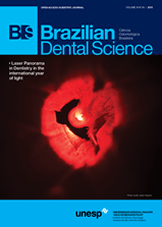Evaluation of root roughness after using diamond tips, ultrasound tips, and hand curettes in human teeth, in vitro study
DOI:
https://doi.org/10.14295/bds.2015.v18i4.1220Abstract
ABSTRACT
Objective: This in vitro study aimed to compare the degree of root roughness in human teeth after using hand curettes, stainless steel, and diamond ultrasound tips. Material and Methods: The scaling was performed on the root surface of 36 human teeth previously standardized and randomly divided into three groups (n = 12). The roughness degree was measured with the aid of a rugosimeter, before and after the scaling, through readings perpendicular and parallel to the scaling direction. The statistical analysis comprised Wilcoxon and Kruskal-Wallis tests (p < 0.05). The qualitative and visual complementation of the results was performed by scanning electronic microscopy. Results: The scaling executed with hand curettes increased root roughness (before - Ra median = 0.1583 µm; after = 0.7783 µm; before - Rz median =1.667 µm; after = 7.350 µm). The degree of root roughness also increased when stainless steel ultrasound (before - Ra median = 0.1483 µm; after = 0.3933 µm; before- Rz median = 1.567 µm; after = 4.333 µm) and diamond tips were used (before - Ra median = 0.1800 µm; after = 2.457 µm; before - Rz median = 1.850 µm; after = 18.58 µm). Conclusion: The superficial roughness significantly increased in all groups. The scaling with diamond tips promoted the greatest root roughness than hand curettes and ultrasound tips.
Keywords: Dental biofilm; Dental scaling; Periodontics; Superficial roughness.
Downloads
Downloads
Published
How to Cite
Issue
Section
License
Brazilian Dental Science uses the Creative Commons (CC-BY 4.0) license, thus preserving the integrity of articles in an open access environment. The journal allows the author to retain publishing rights without restrictions.
=================




























